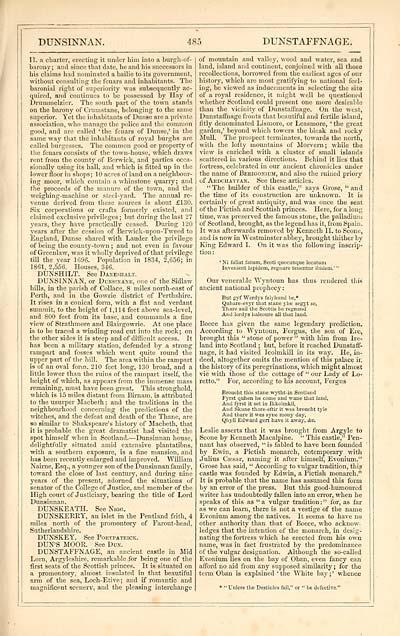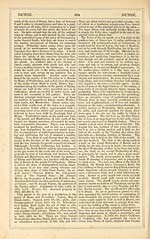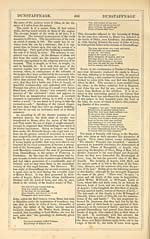Download files
Complete book:
Individual page:
Thumbnail gallery: Grid view | List view

DUNSINNAN.
485
DUNSTAFFNAGE.
II. a charter, erecting it under him into a burgh-of-
barony ; and since that date, he and his successors in
his claims had nominated a bailie to its government,
without consulting the feuars and inhabitants. The
baronial right of superiority was subsequently ac-
quired, and continues to be possessed by Hay of
Drummelzier. The south part of the town stands
on the barony of Crumstane, belonging to the same
superior. Yet the inhabitants of Dunse are a private
association, who manage the police and the common
good, and are called ' the feuars of Dunse,' in the
same way that the inhabitants of royal burghs are
called burgesses. The common good or property of
the feuars consists of the town-house, which draws
rent from the county of Berwick, and parties occa-
sionally using its hall, and which is fitted up in the
lower floor in shops; 10 acres of land on a neighbour-
ing moor, which contain a whinstone quarry; and
the proceeds of the manure of the town, and the
weighing-machine or steel-yard. The annual re-
venue derived from these sources is about £130.
Six corporations or crafts formerly existed, and
claimed exclusive privileges ; but during the last 27
years, they have practically ceased. During 120
years after the cession of Berwick-upon-Tweed to
England, Dunse shared with Lauder the privilege
of being the county-town ; and not even in favour
of Greenlaw, was it wholly deprived of that privilege
till the vear 1696. Population in 1834, 2,656; in
1861, 2,556. Houses, 346.
DUNSHILT. See Daxeshalt.
DUNSINNAN, or Dunsinane, one of the Sidlaw
hills, in the parish of Collace, 8 miles north-east of
Perth, and in the Gowrie district of Perthshire.
It rises in a conical form, with a flat and verdant
summit, to the height of 1,114 feet above sea-level,
and 800 feet from its base, and commands a fine
view of Strathmore and Blairgowrie. At one place
is to be traced a winding road cut into the rock; on
the other sides it is steep and of difficult access. It
has been a military station, defended by a strong
rampart and fosses which went quite round the
upper part of the hill. The area within the rampart
is of an oval form, 210 feet long, 130 broad, and a
little lower than the ruins of the rampart itself, the
height of which, as appears from the immense mass
remaining, must have been great. This stronghold,
which is 15 miles distant from Biniam, is attributed
to the usurper Macbeth ; and the traditions in the
neighbourhood concerning the predictions of the
witches, and the defeat and death of the Thane, are
so similar to Shakspeare's history of Macbeth, that
it is probable the great dramatist had visited the
spot himself when in Scotland. — Dunsinnan house,
delightfully situated amid extensive plantatibns,
with a southern exposure, is a fine mansion, and
has been recently enlarged and improved. William
Naime, Esq., a younger son of the Dunsinnan family,
toward the close of last century, and during nine
years of the present, adorned the situations of
senator of the College of Justice, and member of the
High court of Justiciary, bearing the title of Lord
Dunsinnan.
DUNSKEATH. See Niqg.
DUNSKEERY, an islet in the Pentland frith, 4
miles north of the promontory of Farout-head,
Sutherlandshire.
DUNSKEY. See Pokttatrick.
DUN'S MOOR. See Dun.
DUNSTAFFNAGE, an ancient castle in Mid
Lorn, Argyleshire, remarkable for being one of the
first seats of the Scottish princes. It is situated on
a promontory, almost insulated in that beautiful
arm of the sea, Loeh-Etive; and if romantic and
magnificeut scenery, and the pleasing interchange
of mountain and valley, wood and water, sea and
land, island and continent, conjoined with all those
recollections, borrowed from the earliest ages of our
history, which arc most gratifying to national feel-
ing, he viewed as inducements in selecting the situ
of a royal residence, it might well be questioned
whether Scotland could present one more desirable
than the vicinity of Dunstaifnage. On the west,
Dunstaffnage fronts that beautiful and fertile island,
fitly denominated Lismore, or Leasmore, ' the great
garden,' beyond which towers the bleak and rocky
Mull. The prospect terminates, towards the north,
with the lofty mountains of Morvem; while the
view is enriched with a cluster of small islands
scattered in various directions. Behind it lies that
fortress, celebrated in our ancient chronicles under
the name of Berigonium, and also the ruined priory
of Ardchattan. See these articles.
"The builder of this castle," says Grose, "and
the time of its construction are unknown. It is
certainly of great antiquity, and was once the seat
of the Pictish and Scottish princes. Here, for a long
time, was preserved the famous stone, the palladium
of Scotland, brought, as the legend has it, from Spain.
It was afterwards removed by Kenneth II. to Scone,
and is now in Westminster abbey, brought thither by
King Edward I. On it was the following inscrip-
tion:
1 Ni fallat fatum, Scoti quocunque locatuni
Invenient lapidem, reguare tenentur ibidem."'
Our venerable Wyntoun has thus rendered this
ancient national prophecy :
But gyf Werdys falyliand be,*
Quhare-evyr that stane ybe segyt se,
Thare sail the Scotlis be regnand
And lordys haleoure all that laud.
Boece has given the same legendary prediction.
According to Wyntoun, Fergus, the son of Ere,
brought this "stone of power" with him from Ire-
land into Scotland ; but, before it reached Dunstaff-
nage, it had visited Icolmkill in its way. He, in-
deed, altogether omits the mention of this palace in
the history of its peregrinations, which might almost
vie with those of the cottage of " our Lady of Lo-
retto." For, according to his account, Fergus
Broucht this stane wytht-in Scotland
Fyrst quhen he come and wane that land.
And fyrst it set in Ikkoluikil,
And Skune thare-eftir it wes broucht tyle
And thare it wes syne mony day,
Qhyll Edward gert have it away, &c
Leslie asserts that it was brought from Argyle to
Scone by Kenneth Macalpine. " This castle," Pen-
nant has observed, " is fabled to have been founded
by Ewin, a Pictish monarch, cotemporary with
Julius Caesar, naming it after himself, Evonium."
Grose has said, " According to vulgar tradition, this
castle was founded by Edwin, a Pictish monarch."
It is probable that the name has assumed this form
by an error of the press. But this good-humoured
writer has undoubtedly fallen into an error, when he
speaks of this as "a vulgar tradition:" for, as far
as we can learn, there is not a vestige of the name
Evonium among the natives. It seems to have no
other authority than that of Boece, who acknow-
ledges that the intention of the monarch, in desig-
nating the fortress which he erected from his own
name, was in fact frustrated by the predominance
of the vulgar designation. Although the so-called
Evonium lies on the bay of Oban, even fancy can
afford no aid from any supposed similarity ; for the
term Oban is explained ' the White bay ; ' whence
* "Unless the Destinies fail," or " be defective."
485
DUNSTAFFNAGE.
II. a charter, erecting it under him into a burgh-of-
barony ; and since that date, he and his successors in
his claims had nominated a bailie to its government,
without consulting the feuars and inhabitants. The
baronial right of superiority was subsequently ac-
quired, and continues to be possessed by Hay of
Drummelzier. The south part of the town stands
on the barony of Crumstane, belonging to the same
superior. Yet the inhabitants of Dunse are a private
association, who manage the police and the common
good, and are called ' the feuars of Dunse,' in the
same way that the inhabitants of royal burghs are
called burgesses. The common good or property of
the feuars consists of the town-house, which draws
rent from the county of Berwick, and parties occa-
sionally using its hall, and which is fitted up in the
lower floor in shops; 10 acres of land on a neighbour-
ing moor, which contain a whinstone quarry; and
the proceeds of the manure of the town, and the
weighing-machine or steel-yard. The annual re-
venue derived from these sources is about £130.
Six corporations or crafts formerly existed, and
claimed exclusive privileges ; but during the last 27
years, they have practically ceased. During 120
years after the cession of Berwick-upon-Tweed to
England, Dunse shared with Lauder the privilege
of being the county-town ; and not even in favour
of Greenlaw, was it wholly deprived of that privilege
till the vear 1696. Population in 1834, 2,656; in
1861, 2,556. Houses, 346.
DUNSHILT. See Daxeshalt.
DUNSINNAN, or Dunsinane, one of the Sidlaw
hills, in the parish of Collace, 8 miles north-east of
Perth, and in the Gowrie district of Perthshire.
It rises in a conical form, with a flat and verdant
summit, to the height of 1,114 feet above sea-level,
and 800 feet from its base, and commands a fine
view of Strathmore and Blairgowrie. At one place
is to be traced a winding road cut into the rock; on
the other sides it is steep and of difficult access. It
has been a military station, defended by a strong
rampart and fosses which went quite round the
upper part of the hill. The area within the rampart
is of an oval form, 210 feet long, 130 broad, and a
little lower than the ruins of the rampart itself, the
height of which, as appears from the immense mass
remaining, must have been great. This stronghold,
which is 15 miles distant from Biniam, is attributed
to the usurper Macbeth ; and the traditions in the
neighbourhood concerning the predictions of the
witches, and the defeat and death of the Thane, are
so similar to Shakspeare's history of Macbeth, that
it is probable the great dramatist had visited the
spot himself when in Scotland. — Dunsinnan house,
delightfully situated amid extensive plantatibns,
with a southern exposure, is a fine mansion, and
has been recently enlarged and improved. William
Naime, Esq., a younger son of the Dunsinnan family,
toward the close of last century, and during nine
years of the present, adorned the situations of
senator of the College of Justice, and member of the
High court of Justiciary, bearing the title of Lord
Dunsinnan.
DUNSKEATH. See Niqg.
DUNSKEERY, an islet in the Pentland frith, 4
miles north of the promontory of Farout-head,
Sutherlandshire.
DUNSKEY. See Pokttatrick.
DUN'S MOOR. See Dun.
DUNSTAFFNAGE, an ancient castle in Mid
Lorn, Argyleshire, remarkable for being one of the
first seats of the Scottish princes. It is situated on
a promontory, almost insulated in that beautiful
arm of the sea, Loeh-Etive; and if romantic and
magnificeut scenery, and the pleasing interchange
of mountain and valley, wood and water, sea and
land, island and continent, conjoined with all those
recollections, borrowed from the earliest ages of our
history, which arc most gratifying to national feel-
ing, he viewed as inducements in selecting the situ
of a royal residence, it might well be questioned
whether Scotland could present one more desirable
than the vicinity of Dunstaifnage. On the west,
Dunstaffnage fronts that beautiful and fertile island,
fitly denominated Lismore, or Leasmore, ' the great
garden,' beyond which towers the bleak and rocky
Mull. The prospect terminates, towards the north,
with the lofty mountains of Morvem; while the
view is enriched with a cluster of small islands
scattered in various directions. Behind it lies that
fortress, celebrated in our ancient chronicles under
the name of Berigonium, and also the ruined priory
of Ardchattan. See these articles.
"The builder of this castle," says Grose, "and
the time of its construction are unknown. It is
certainly of great antiquity, and was once the seat
of the Pictish and Scottish princes. Here, for a long
time, was preserved the famous stone, the palladium
of Scotland, brought, as the legend has it, from Spain.
It was afterwards removed by Kenneth II. to Scone,
and is now in Westminster abbey, brought thither by
King Edward I. On it was the following inscrip-
tion:
1 Ni fallat fatum, Scoti quocunque locatuni
Invenient lapidem, reguare tenentur ibidem."'
Our venerable Wyntoun has thus rendered this
ancient national prophecy :
But gyf Werdys falyliand be,*
Quhare-evyr that stane ybe segyt se,
Thare sail the Scotlis be regnand
And lordys haleoure all that laud.
Boece has given the same legendary prediction.
According to Wyntoun, Fergus, the son of Ere,
brought this "stone of power" with him from Ire-
land into Scotland ; but, before it reached Dunstaff-
nage, it had visited Icolmkill in its way. He, in-
deed, altogether omits the mention of this palace in
the history of its peregrinations, which might almost
vie with those of the cottage of " our Lady of Lo-
retto." For, according to his account, Fergus
Broucht this stane wytht-in Scotland
Fyrst quhen he come and wane that land.
And fyrst it set in Ikkoluikil,
And Skune thare-eftir it wes broucht tyle
And thare it wes syne mony day,
Qhyll Edward gert have it away, &c
Leslie asserts that it was brought from Argyle to
Scone by Kenneth Macalpine. " This castle," Pen-
nant has observed, " is fabled to have been founded
by Ewin, a Pictish monarch, cotemporary with
Julius Caesar, naming it after himself, Evonium."
Grose has said, " According to vulgar tradition, this
castle was founded by Edwin, a Pictish monarch."
It is probable that the name has assumed this form
by an error of the press. But this good-humoured
writer has undoubtedly fallen into an error, when he
speaks of this as "a vulgar tradition:" for, as far
as we can learn, there is not a vestige of the name
Evonium among the natives. It seems to have no
other authority than that of Boece, who acknow-
ledges that the intention of the monarch, in desig-
nating the fortress which he erected from his own
name, was in fact frustrated by the predominance
of the vulgar designation. Although the so-called
Evonium lies on the bay of Oban, even fancy can
afford no aid from any supposed similarity ; for the
term Oban is explained ' the White bay ; ' whence
* "Unless the Destinies fail," or " be defective."
Set display mode to: Large image | Transcription
Images and transcriptions on this page, including medium image downloads, may be used under the Creative Commons Attribution 4.0 International Licence unless otherwise stated. ![]()
| Gazetteers of Scotland, 1803-1901 > Imperial gazeteer of Scotland, or, Dictionary of Scottish topography > Volume 1 > (603) Page 485 |
|---|
| Permanent URL | https://digital.nls.uk/97466366 |
|---|
| Description | Volume I: Aan-Gordon. |
|---|---|
| Attribution and copyright: |
|

